Comet Neat
This image of comet C/2001 Q4 (NEAT) was taken at the WIYN 0.9-meter telescope at Kitt Peak National Observatory near Tucson, Arizona, on May 7, 2004.
This image of comet C/2001 Q4 (NEAT) was taken at the WIYN 0.9-meter telescope at Kitt Peak National Observatory near Tucson, Arizona, on May 7, 2004.
The image was captured with the Mosaic I camera, which has a one-square degree field of view, or about five times the size of the Moon. Even with this large field, only the comet's coma and the inner portion of its tail are visible. A small star cluster (C0736-105, or Melotte 72) is visible in the lower right of the image, between the head of the comet and the bright red star in the lower-right corner. (Courtesy NASA, NOAO, NSF, STScI)
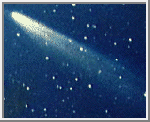 Comet Kohoutek
Comet Kohoutek
This color photograph of the comet Kohoutek was taken by members of the lunar and planetary laboratory photographic team from the University of Arizona. They photographed the comet from the Catalina observatory with a 35mm camera on January 11, 1974. (Courtesy NASA)
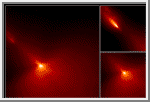 Comet Hyakutake
Comet Hyakutake
These Hubble Space Telescope images of comet Hyakutake were taken on March 25, 1996 when the comet passed at a distance of 9.3 million miles from Earth. These images focus on a very small region near the heart of the comet, the icy, solid nucleus and provide an exceptionally clear view of the near-nucleus region of the comet.
 Comet Kohoutek
Comet KohoutekThis color photograph of the comet Kohoutek was taken by members of the lunar and planetary laboratory photographic team from the University of Arizona. They photographed the comet from the Catalina observatory with a 35mm camera on January 11, 1974. (Courtesy NASA)
 Comet Hyakutake
Comet HyakutakeThese Hubble Space Telescope images of comet Hyakutake were taken on March 25, 1996 when the comet passed at a distance of 9.3 million miles from Earth. These images focus on a very small region near the heart of the comet, the icy, solid nucleus and provide an exceptionally clear view of the near-nucleus region of the comet.
The left image is 2070 miles across (3340 km) and shows that most of the dust is being produced on the sunward-facing hemisphere of the comet. Also at upper left are three small pieces which have broken off the comet and are forming their own tails. Icy regions on the nucleus are activated as they rotate into sunlight, ejecting large amounts of dust in the jets that are faintly visible in this image. Sunlight striking this dust eventually turns it around and "blows" it into the tailward hemisphere.
The bottom-right image is an expanded view of the near-nucleus region and is only 470 miles (760 km) across. The nucleus is near the center of the frame, but the brightest area is probably the tip of the strongest dust jet rather than the nucleus itself. Presumably, the nucleus surface lies just below this bright jet. The top-right image shows pieces of the nucleus that apparently broke off. The image shows at least three separate objects that are probably made up of coarse-grained dust. Large fragments of the nucleus would not be accelerated into the tail, which appears to be the case in this image. (Credit: H. A. Weaver--Applied Research Corp., HST Comet Hyakutake Observing Team, and NASA)
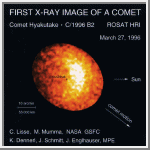 First X-Rays From Comet Hyakutake Discovered
First X-Rays From Comet Hyakutake Discovered
This image shows the discovery of a strong X-ray radiation signal coming from comet Hyakutake. The image was made on March 27, 1996 using Germany's orbiting ROSAT satellite. The comet was near its closest approach to the Earth at a distance of less than 10 million miles when X-ray emmisions were first detected by ROSAT. The strength and rapid changes in intensity of the comet's X-ray emission both surprised and puzzled astronomers. "We had no clear expectation that comets shine in X-rays," said Dr. Michael J. Mumma of NASA's Goddard Space Flight Center, Greenbelt, MD. X-rays have never been found from a comet before, and scientists had optimistically predicted an intensity that turned out to be about 100 times weaker than the radiation actually detected by ROSAT. Strong changes in the brightness of the X-rays were another surprise. There were pronounced increases and decreases in the X-ray brightness from one ROSAT observation to another, typically over a time difference of a few hours.
 First X-Rays From Comet Hyakutake Discovered
First X-Rays From Comet Hyakutake DiscoveredThis image shows the discovery of a strong X-ray radiation signal coming from comet Hyakutake. The image was made on March 27, 1996 using Germany's orbiting ROSAT satellite. The comet was near its closest approach to the Earth at a distance of less than 10 million miles when X-ray emmisions were first detected by ROSAT. The strength and rapid changes in intensity of the comet's X-ray emission both surprised and puzzled astronomers. "We had no clear expectation that comets shine in X-rays," said Dr. Michael J. Mumma of NASA's Goddard Space Flight Center, Greenbelt, MD. X-rays have never been found from a comet before, and scientists had optimistically predicted an intensity that turned out to be about 100 times weaker than the radiation actually detected by ROSAT. Strong changes in the brightness of the X-rays were another surprise. There were pronounced increases and decreases in the X-ray brightness from one ROSAT observation to another, typically over a time difference of a few hours.
Still another puzzle is the nature of the physical process that generates the X-rays, but the ROSAT image may contain clues to this process. In the image, the X-rays from the comet seem to come from a crescent-shaped region on the sunward side of Comet Hyakutake. One preliminary theory is that X-ray emission from the Sun was absorbed by a cloud of gaseous water molecules surrounding the nucleus of the comet, and then were re-emitted by the molecules in a process physicists call "fluorescence." According to this idea, the cloud is so thick that its sunward side absorbs nearly all the incoming solar X-rays, so that none reach the remainder of the cloud. This could explain why the cometary X-ray emission has the form of a crescent, rather than that of a sphere around the nucleus. A second possible explanation is that the X-rays are produced from the violent collision between the comet material and the supersonic "wind" of plasma and particles streaming away from the Sun.
 Comet 1993a Mueller
Comet 1993a Mueller
This is a CCD image of comet 1993a Mueller, taken on October 6, 1993 with a 288mm f/5.2 Schmidt-Cassegrain telescope. The comet has a coma diameter of 3' and a fan-shaped tail, up to 7' long. (Courtesy Erich Meyer and Herbert Raab, Austria)
 Comet West (1975)
Comet West (1975)
This photograph was taken by amateur astronomer John Loborde on March 9, 1976. This picture shows two distinct tails. The thin blue plasma tail is made up of gases and the broad white tail is made up of microscopic dust particles.(Courtesy John Laborde)
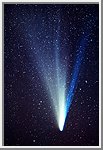 Comet West (1975)
Comet West (1975)
This image of comet West was taken by John Laborde at the Tierra Del Sol Observatory site in San Diego County. The exposure was 30 minutes with a 135 mm Nikon lens. (Courtesy John Laborde)
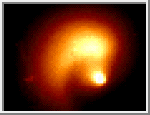 Comet Hale-Bopp
Comet Hale-Bopp
These NASA Hubble Space Telescope pictures of comet Hale-Bopp show a remarkable "pinwheel" pattern and a blob of free-flying debris near the nucleus. The bright clump of light along the spiral (above the nucleus, which is near the center of the frame) may be a piece of the comet's icy crust that was ejected into space by a combination of ice evaporation and the comet's rotation, and which then disintegrated into a bright cloud of particles.
 Comet 1993a Mueller
Comet 1993a MuellerThis is a CCD image of comet 1993a Mueller, taken on October 6, 1993 with a 288mm f/5.2 Schmidt-Cassegrain telescope. The comet has a coma diameter of 3' and a fan-shaped tail, up to 7' long. (Courtesy Erich Meyer and Herbert Raab, Austria)
 Comet West (1975)
Comet West (1975)This photograph was taken by amateur astronomer John Loborde on March 9, 1976. This picture shows two distinct tails. The thin blue plasma tail is made up of gases and the broad white tail is made up of microscopic dust particles.(Courtesy John Laborde)
 Comet West (1975)
Comet West (1975)This image of comet West was taken by John Laborde at the Tierra Del Sol Observatory site in San Diego County. The exposure was 30 minutes with a 135 mm Nikon lens. (Courtesy John Laborde)
 Comet Hale-Bopp
Comet Hale-BoppThese NASA Hubble Space Telescope pictures of comet Hale-Bopp show a remarkable "pinwheel" pattern and a blob of free-flying debris near the nucleus. The bright clump of light along the spiral (above the nucleus, which is near the center of the frame) may be a piece of the comet's icy crust that was ejected into space by a combination of ice evaporation and the comet's rotation, and which then disintegrated into a bright cloud of particles.
Although the "blob" is about 3.5 times fainter than the brightest portion at the nucleus, the lump appears brighter because it covers a larger area. The debris follows a spiral pattern outward because the solid nucleus is rotating like a lawn sprinkler, completing a single rotation about once per week.
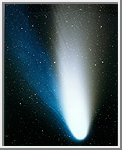 Comet Hale-Bopp
Comet Hale-Bopp
This image of comet Hale-Bopp was taken by John Laborde with his home designed and built, 8.8" f/3.7 Wright Schmidt Camera. The picture was taken at the Tierra Del Sol Observatory site in San Diego County with a 25 minute exposure on Kodak PPF400 film. (Courtesy John Laborde)
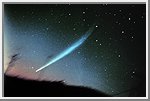 Comet Ikeya-Seki
Comet Ikeya-Seki
This image of comet Ikeya-Seki was taken by John Laborde in Poway, California just before dawn. The exposure was 15 minutes with a 55 mm Nikon lens. (Courtesy John Laborde)
 Comet Hale-Bopp
Comet Hale-BoppThis image of comet Hale-Bopp was taken by John Laborde with his home designed and built, 8.8" f/3.7 Wright Schmidt Camera. The picture was taken at the Tierra Del Sol Observatory site in San Diego County with a 25 minute exposure on Kodak PPF400 film. (Courtesy John Laborde)
 Comet Ikeya-Seki
Comet Ikeya-SekiThis image of comet Ikeya-Seki was taken by John Laborde in Poway, California just before dawn. The exposure was 15 minutes with a 55 mm Nikon lens. (Courtesy John Laborde)

No comments:
Post a Comment